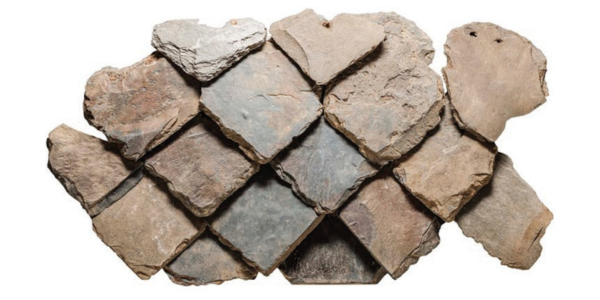Explore the ancient history of slate roofs

By Hannah Ford.
Journey through time to explore the transition from early Roman techniques to a Welsch slate empire.
Slate has been used throughout history to create and craft roofs. It is formed from sediment derived from clay or volcanic ash. The slate is cut into thin durable sheets and then installed on roofs. The origins of slate roofs date back thousands of years and have continued to evolve and change depending on the time and region.
1st Century
Evidence has been found in an ancient Roman villa in Abermagwr, Wales of past slate usage. Between the 1st and 4th century A.D., a slate quarry provided large sheets of slate to use on roofs. Templates were found nearby that were used to mark the slate to be cut. An axe like tool was used to create a hexagonal form or diamond shape over one centimeter thick. “The Roman civilization, the basis of the Western world as we know it, was the first to extract, work, transport and install standard sized slate on roofs,” Dr. Víctor Cárdenes Van den Eynde, geologist and roofing slate consultant, wrote to Cupa Pizarras. “It was worked regularly in areas where there were slate deposits.”
The Romans had a very similar style of slate placement to current Germanic placement. The cut slate was secured to a wooden roof structure with wooden or iron nails; holes were drilled before the nails were inserted.
When the Romans invaded Britain in 43 A.D. they brought slate roofing with them. Slate was a dangerous material to procure because both the quarrying and transporting was long and strenuous. The largest Roman fort Segontium was made with a slate roof. The most important Roman slate quarry was located in Swithland and had a very high production rate for the time, producing Cambrian green and purple slate. In a town a few miles south of the large quarries, several homes were excavated with slate roofs.
Middle Ages
“Once the Romans left the Isles in the 5th century, the roofing slate tradition was forgotten, or at least there are no records of it. Saxons did not use slate very much; they preferred thatch roofs. Stone in general was reserved for churches,” Víctor said to Cupa Pizarras. “However, this changed by the 11th century, with the arrival of the Normans.” Several castles began to adopt slate roofing once the Normans brought a new architectural style. Calder Abbey, founded in 1134, and Conway Castle, founded in 1289, both had slate roofs. Later in 1445, 130,000 slate pieces were ordered to repair Dumbarton Castle.
Many wealthy people and institutions from Great Britain were using the new slate roofing style. For hundreds of years, military structures and castles were the only buildings with slate roofs. The first recording of a slate roof installed on a private home was in North Wales around 1300.
Renaissance Period
The first slate quarry under ownership was in 1439, South Devon, by the Earl of Warwick. During the Renaissance Period, slate became more affordable for homeowners and slate was in high demand. In 1570, a poet by the name of Sion Tudor wrote a poetic letter requesting slate to cover his roof. Slate roofing was installed with a double-lap system during the Renaissance Period to help it be more weather resistant.
Wales was the top and only producer of slate for a considerable amount of time. They continued to dominate even when other countries began to enter the industry. The Welsh slate was centered in Bethesda where the Penrhyn Quarry was located. The quarry was the largest in the world and well known for its durability and beauty. In other European countries, roofing slate quarries would be rented to workers who were required to pay for use. Wales had been collecting slate since the 12th century and it wasn’t until the 17th century that countries like Scotland began to join in. While the Scottish slate industry was not as robust as the Welsh, it was still successful. Slate quarries were located all around the Scottish Highlands. Scottish slate would be used for all types of buildings and was resistant to the harsh weather in Scotland.
Present
Eventually, slate roofing went out of style. It was once the most desirable roofing type, but it took a turn during the 20th century. Slate has slowly made a comeback but is still not as popular as it once was in ancient history. Slate can last hundreds of years and is extremely durable.
Original image source: Cupa Pizarras
Stay up to date with the latest industry news when you sign up for the Coffee Shop eNews.
About Hannah
Hannah Ford is a content intern for the Coffee Shops. She is a student at Oregon State University pursuing her bachelor of science in marketing. In her free time she enjoys reading, art, music and trying new restaurants.























Comments
Leave a Reply
Have an account? Login to leave a comment!
Sign In